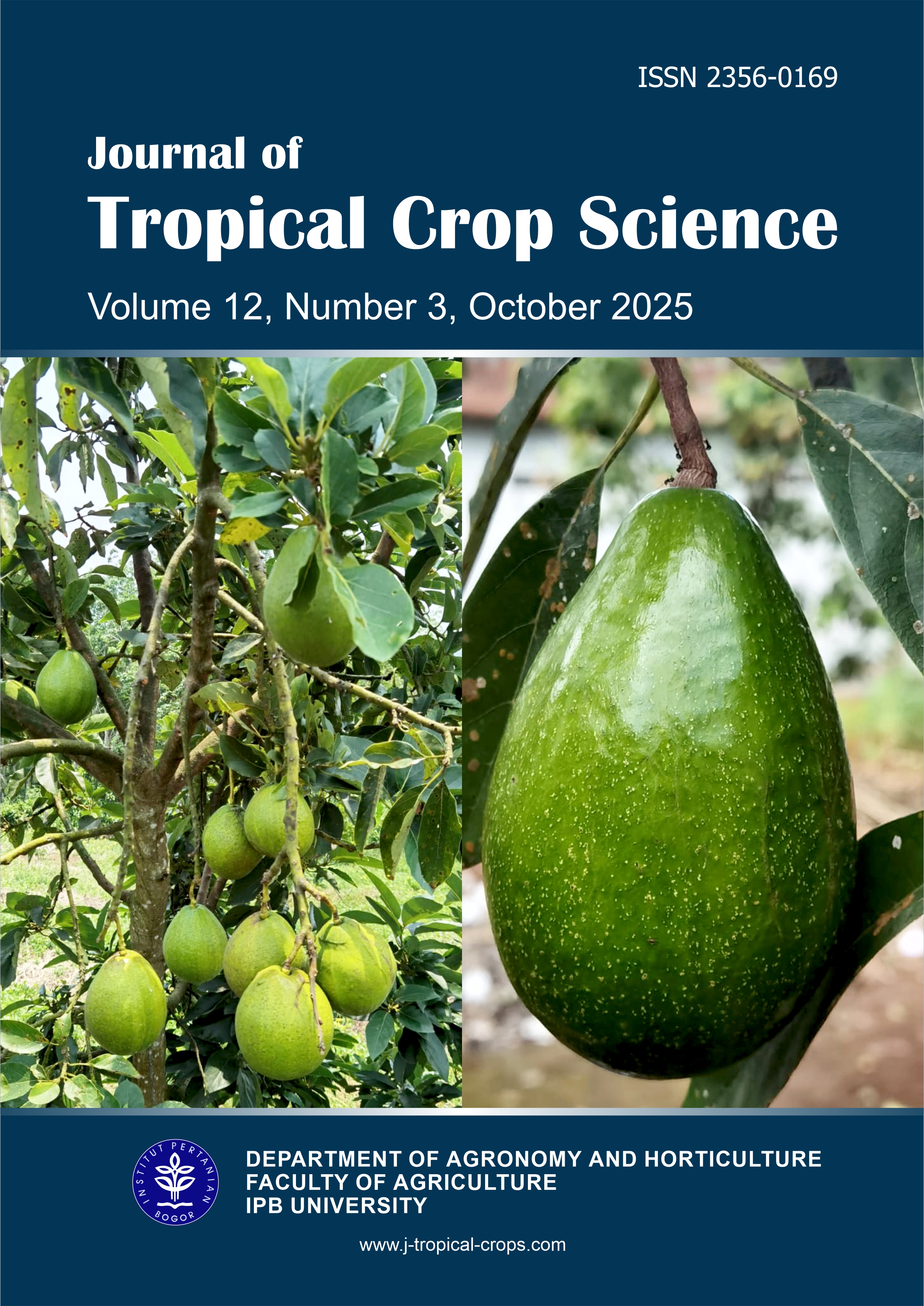Optimizing Tissue Culture for Yellow Dragon Fruit (Selenicereus megalanthus) Propagation: Enhancing Shoot and Root Induction
DOI:
https://doi.org/10.29244/jtcs.12.03.663-671Keywords:
BAP, callus, Cactaceae, cytokinin, NAAAbstract
Yellow dragon fruit (Selenicereus megalanthus) "Palora" variety is a tropical cactus recognized for its yellow pericarp, white mesocarp, and black seeds. Dragon fruits are also known as pitaya. The yellow pitaya variant is regarded as the sweetest and most nutrient-dense, with high commercial value among the commonly cultivated pitaya types. However, large-scale cultivation of yellow dragon fruit remains limited by propagation constraints. The conventional propagation method using vegetative stem cuttings is labour-intensive and results in inconsistent growth and genetic variability. Tissue culture has emerged as a viable biotechnological alternative, enabling rapid multiplication of genetically uniform and disease-free plantlets under controlled conditions. The study aimed to optimize tissue culture medium for enhancing shoot induction on yellow dragon fruit. The experiments were conducted in two steps. The first step evaluated the explant response in MS medium containing 3 mg.L-1 BAP and varying NAA concentrations (0.1, 0.2, 1, 2, and 3 mg.L-1). The results showed that an elevation in NAA concentration promoted progressive growth in shoots, roots, and callus. However, when NAA was further augmented to 3 mg.L-1, shoot and root formation were repressed, while callus formation increased. The second step evaluated the combined effects of auxin and cytokinin on shoot formation. A factorial treatment design was applied using combinations of three NAA concentrations (1, 2, and 3 mg.L-1) and three BAP concentrations (1, 2, and 3 mg.L-1), resulting in nine treatment combinations, with the lowest concentration (NAA 1 mg.L-1 + BAP 1 mg.L-1) as the control. Statistical analysis revealed that NAA, BAP, and their interaction had a significant effect on the number of shoots. The optimal treatment for producing the highest number of shoots is a combination of NAA at 3 mg.L-1 and BAP at 2 mg.L-1.
References
Aremu, A.O., Fawole, O.A., Makunga, N.P., Masondo, N.A., Moyo, M., Buthelezi, N.M.D., Amoo, S.O., Spíchal, L., and Doležal, K. (2020). Applications of cytokinins in horticultural fruit crops: Trends and prospects. Biomolecules 10, 1222. DOI: https://doi.org/10.3390/biom10091222.
Alsanie, S.I. (2025). Insights on the Mesembryanthemum forsskalii phenotype and study of the effects of several exogenous plant growth regulators via plant tissue culture. BMC Plant Biology 25. DOI: https://doi.org/10.1186/s12870-024-06029-w.
Bello-Bello, J.J., Schettino-Salomón, S., Ortega Espinoza, J., and Spinoso-Castillo, J.L. (2021). A temporary immersion system for mass micropropagation of pitahaya (Hylocereus undatus). 3 Biotechnology 11. DOI: https://doi.org/10.1007/s13205-021-02984-5.
Biswas, R., Sarkar, D., Mishra, S., and Das, S. (2024). Dragon fruit: Nutritional composition and therapeutic value. Journal of Current Research in Food Science 5, 87–89. DOI: https://doi.org/10.22271/foodsci.2024.v5.i2b.163.
Dahanayake, N., and Ranawake, A. (2012). Regeneration of dragon fruit (Hylecereus undatus) plantlets from leaf and stem explants. Tropical Agricultural Research and Extension 14, 85. DOI: https://doi.org/10.4038/tare.v14i4.4848.
Gonzales-Alvarado, A.C., and Cardoso, J.C. (2024). Development, chlorophyll content, and nutrient accumulation in in vitro shoots of Melaleuca alternifolia under light wavelengths and 6-BAP. Plants (Basel) 13, 2842. DOI: https://doi.org/10.3390/plants13202842.
Hua, Q., Chen, P., Liu, W., Ma, Y., Liang, R., Wang, L., Wang, Z., Hu, G., and Qin, Y. (2014). A protocol for rapid in vitro propagation of genetically diverse itaya. Plant Cell Tissue and Organ Culture (PCTOC) 120, 741–745. DOI: https://doi.org/10.1007/s11240-014-0643-9.
Ikeuchi, M., Sugimoto, K., Iwase, A. (2013). Plant callus: mechanisms of induction and repression. Plant Cell 25, 3159-3173. DOI: https://doi.org/10.1105/tpc.113.116053.
Infante, R. (1992). In vitro axillary shoot proliferation and somatic embryogenesis of yellow pitaya Mediocactus coccineus (Salm-Dyck). Plant Cell Tissue and Organ Culture (PCTOC) 31, 155–159. DOI: https://doi.org/10.1007/bf00037700.
Lee, Y., and Chang, J. (2022). Development of an improved micropropagation protocol for red fleshed pitaya ‘Da Hong’ with and without activated charcoal and plant growth regulator combinations. Horticulturae 8, 104. DOI: https://doi.org/10.3390/horticulturae8020104.
Mahmod, N.H., Lema, A.A., Kamarudin, S.F., Shari, N., Abdullah, T.A., and Dogara, A.M. (2021). Effect of plant growth regulators, basal media strength, and carbon sources on Hylocereus costaricensis (Red dragon fruit) seed germination. Eurasian Journal of Science and Engineering 7. DOI: https://doi.org/10.23918/eajse.v7i2p149.
Murashige, T., and Skoog, F. (1962). A revised medium for rapid growth and bioassays with tobacco tissue cultures. Plant Physiology 15, 473-497. DOI: https://doi.org/10.1111/j.1399-3054.1962.tb08052.x.
Mustafa, S., and Saad, M.M.A. (2020). Propagation and Preservation of Hylocereus undatus via tissue culture technique. Journal of Basic and Appied Science Research 10.
Nishikito, D.F., Borges, A.C.A., Laurindo, L.F., Otoboni, A.M.M.B., Direito, R., De Alvares Goulart, R., Nicolau, C.C.T., Fiorini, A.M.R., Sinatora, R.V., and Barbalho, S.M. (2023). Anti-Inflammatory, antioxidant, and other health effects of dragon fruit and potential delivery systems for its bioactive compounds. Pharmaceutics 15, 159. DOI: https://doi.org/10.3390/pharmaceutics15010159.
Nunez, D., Escobar, R.H., Caetano, C., and Vaca, J.C.V. (2014). Standardization of a regeneration protocol in yellow pitahaya (Selenicereus megalanthus (K. Schum.ex Vaupel) Moran). Acta Agronomica 63, 32-43. DOI: https://doi.org/10.15446/acag.v63n1.36051.
Pelah, D., Kaushik, R.A., Mizrahi, Y., et al. (2002). Organogenesis in the vine cactus Selenicereus megalanthus using thidiazuron. Plant Cell, Tissue and Organ Culture 71, 81–84, DOI: https://doi.org/10.1023/A:1016585108094.
Rahman, Z.A. (2015). Establishment organogenesis of protocol for genetic modification of “yellow pitaya” Selenicereus megalanthus (Cactaceae). International Journal of Plant and Soil Science 7, 102-108. DOI: https://journalijpss.com/index.php/IJPSS/article/view/591/1182.
Rehman, M.U., Chaudhary, M., and Kumar, S. (2023). Effect of BAP (6-Benzylaminopurine) and NAA (α-Napthalene Acetic Acid) treatment on micropropagation of Adansonia digitata L. Plant Cell Biotechnology and Molecular Biology 24, 42-51. DOI: https://doi.org/10.56557/pcbmb/2023/v24i3-48292.
Román, R.S.S., Caetano, C.M., Ramírez, H., and Osorio, J.G.M. (2014). Multiplicación de Selenicereus megalanthus (pitahaya amarilla) e Hylocereus polyr-hizus (pitahaya roja) vía organogénesis somática. Acta Agronómica 63, 272–281. DOI: https://doi.org/10.15446/acag.v63n3.40980.
Shin, J., Bae, S., and Seo, P.J. (2020). De novo shoot organogenesis during plant regeneration, Journal of Experimental Botany 71, 63–72. https://doi.org/10.1093/jxb/erz395.
Trivellini, A., Lucchesini, M., Ferrante, A., Massa, D., Orlando, M., Incrocci, L., and Mensuali-Sodi, A. (2020). Pitaya, an attractive alternative crop for the Mediterranean region. Agronomy 10, 1065. DOI: https://doi.org/10.3390/agronomy10081065.
Downloads
Published
How to Cite
Issue
Section
License
All publications by Journal of Tropical Crop Science is licensed under a Creative Commons Attribution-ShareAlike 4.0 International License.






